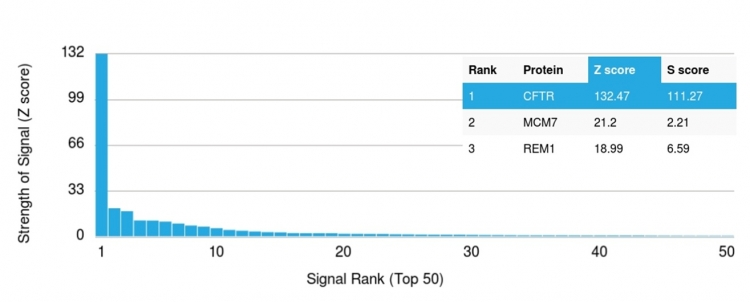![FACS analysis of MOLT-4 cells using GTX34589 CFTR antibody [CFTR/1643]. Blue : Primary antibody Red : Isotype control FACS analysis of MOLT-4 cells using GTX34589 CFTR antibody [CFTR/1643]. Blue : Primary antibody Red : Isotype control](https://www.genetex.com/upload/website/prouct_img/normal/GTX34589/GTX34589_20200115_FACS_1607_w_23060801_332.webp)
FACS analysis of MOLT-4 cells using GTX34589 CFTR antibody [CFTR/1643]. Blue : Primary antibody Red : Isotype control
CFTR antibody [CFTR/1643]
GTX34589
ApplicationsFlow Cytometry, ImmunoHistoChemistry, ImmunoHistoChemistry Paraffin, Other Application
Product group Antibodies
TargetCFTR
Overview
- SupplierGeneTex
- Product NameCFTR antibody [CFTR/1643]
- Delivery Days Customer9
- Application Supplier NoteIHC-P: 1-2microg/ml for 30 minutes at RT. FACS: 1-2microg/106 cells. *Optimal dilutions/concentrations should be determined by the researcher.Not tested in other applications.
- ApplicationsFlow Cytometry, ImmunoHistoChemistry, ImmunoHistoChemistry Paraffin, Other Application
- CertificationResearch Use Only
- ClonalityMonoclonal
- Clone IDCFTR/1643
- Concentration0.2 mg/ml
- ConjugateUnconjugated
- Gene ID1080
- Target nameCFTR
- Target descriptionCF transmembrane conductance regulator
- Target synonymsABC35, ABCC7, CF, CFTR/MRP, MRP7, TNR-CFTR, dJ760C5.1, cystic fibrosis transmembrane conductance regulator, cAMP-dependent chloride channel, channel conductance-controlling ATPase, cystic fibrosis transmembrane conductance regulating, cystic fibrosis transmembrane conductance regulator (ATP-binding cassette sub-family C, member 7)
- HostMouse
- IsotypeIgG2b
- Protein IDP13569
- Protein NameCystic fibrosis transmembrane conductance regulator
- Scientific DescriptionThis gene encodes a member of the ATP-binding cassette (ABC) transporter superfamily. The encoded protein functions as a chloride channel, making it unique among members of this protein family, and controls ion and water secretion and absorption in epithelial tissues. Channel activation is mediated by cycles of regulatory domain phosphorylation, ATP-binding by the nucleotide-binding domains, and ATP hydrolysis. Mutations in this gene cause cystic fibrosis, the most common lethal genetic disorder in populations of Northern European descent. The most frequently occurring mutation in cystic fibrosis, DeltaF508, results in impaired folding and trafficking of the encoded protein. Multiple pseudogenes have been identified in the human genome. [provided by RefSeq, Aug 2017]
- Storage Instruction-20°C or -80°C,2°C to 8°C
- UNSPSC12352203

![IHC-P analysis of human pancreas tissue using GTX34589 CFTR antibody [CFTR/1643]. IHC-P analysis of human pancreas tissue using GTX34589 CFTR antibody [CFTR/1643].](https://www.genetex.com/upload/website/prouct_img/normal/GTX34589/GTX34589_20200115_IHC-P_852_w_23060801_412.webp)

![IHC-P analysis of human colon carcinoma tissue using GTX22784 CFTR antibody [CF3]. Left : Primary antibody Right : Negative control without primary antibody Antigen retrieval : heat induced antigen retrieval was performed using 10mM sodium citrate (pH6.0) buffer, microwaved for 8-15 minutes Dilution : 1:200](https://www.genetex.com/upload/website/prouct_img/normal/GTX22784/GTX22784_1104_IHC-P_w_23060620_131.webp)



![IHC-P analysis of human pancreas tissue using GTX34586 CFTR antibody [CFTR/1341].](https://www.genetex.com/upload/website/prouct_img/normal/GTX34586/GTX34586_20200115_IHC-P_849_w_23060801_630.webp)
![IHC-P analysis of mouse kidney tissue using GTX34587 CFTR antibody [CFTR/1342].](https://www.genetex.com/upload/website/prouct_img/normal/GTX34587/GTX34587_20200115_IHC-P_1621_w_23060801_471.webp)
![IHC-P analysis of human pancreas tissue using GTX34588 CFTR antibody [SPM176].](https://www.genetex.com/upload/website/prouct_img/normal/GTX34588/GTX34588_20200115_IHC-P_851_w_23060801_467.webp)
![IHC-P analysis of human pancreas tissue using GTX34591 CFTR antibody [CFTR/1775R].](https://www.genetex.com/upload/website/prouct_img/normal/GTX34591/GTX34591_20200115_IHC-P_853_w_23060801_190.webp)

